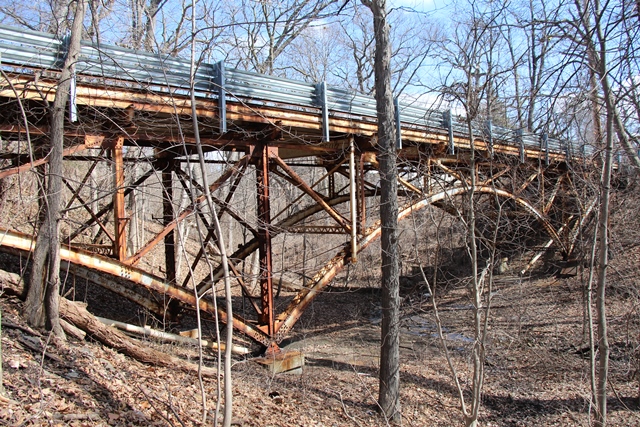We Recommend:
Bach Steel - Experts at historic truss bridge restoration.
BridgeHunter.com Phase 1 is released to the public! - Visit Now
Marengo Street Bridge

Primary Photographer(s): Nathan Holth and Rick McOmber
Bridge Documented: March 28, 2015 and September 7, 2015
Toledo: Lucas County, Ohio: United States
1915 By Builder/Contractor: Standard Engineering Company of Toledo, Ohio and American Bridge Company of New York, New York
1973
85.5 Feet (26.1 Meters)
172.5 Feet (52.6 Meters)
Not Available
3 Main Span(s)
4861035

View Information About HSR Ratings
Bridge Documentation
This bridge's future is at risk!
Bridge Status: This historic bridge is Slated for demolition in 2020!This is one of the smallest known examples of a steel deck cantilever truss bridge.
The historic bridge inventory and other sources online list this as a steel deck arch bridge. However, the original drawings for this bridge clearly describe the bridge as a "cantilever deck bridge" indicating that the bridge actually functions as a deck cantilever truss bridge.
The bridge was fabicated at the Toledo plant of the American Bridge Company.
View Archived National Bridge Inventory Report - Has Additional Details and Evaluation
View Original Plans For This Bridge
Information and Findings From Ohio's Historic Bridge InventorySetting/Context The bridge carries a 2-lane street over a ravine in a residential setting in Toledo. The residences are a mix of late 19th to modern houses without the consistency or integrity of a potential historic district. Physical Description The 3-span, 175'-long, steel arch bridge is composed of built-up arches of standard sections. The two arch ribs (or lower chords) are built-up of curved channel segments with lacing. The segments have riveted splice plates. The arches support verticals and diagonals of back-to-back angles with lacing. The upper chords are angles with lacing. Built-up floorbeams are supported atop the verticals. Everything from the deck up is modern material, including the longitudinal welded steel beams at the deck fasciae. The bridge has beam guide rails. Integrity Everything from the deck up is modern material (ca. 1975, ca. 2005), including railings. The arch has loss of fabric from deterioration of the steel. Summary of Significance The steel arch bridge was selected eligible by ODOT's prior inventory. Other than replacement of the railings (replacing railings that were themselves replacements), there has been no change in the bridge's status. There are 23 steel arches in the ODOT inventory dating from 1897 to 1958. They range from mundane short-span culverts to monumental bridges, like the 1935 Lorain Road Viaduct in Cleveland. This bridge, which is not aesthetic, falls somewhere in between. It is the second oldest steel arch in the inventory, but for its period it was not innovative technology and was a somewhat odd choice for a three-span bridge of this length. Justification The bridge is one of the five extant examples of the type that was used for a variety of crossing types, from major, monumental bridges like the 1917 Detroit-Superior Viaduct in Cleveland to the 1952 Gordon Park Pedestrian bridge over the Memorial Shoreway. It has moderate significance as it is not one of the monumental ones. Bridge Considered Historic By Survey: Yes |
![]()
Photo Galleries and Videos: Marengo Street Bridge
Bridge Photo-Documentation
Original / Full Size PhotosA collection of overview and detail photos. This gallery offers photos in the highest available resolution and file size in a touch-friendly popup viewer.
Alternatively, Browse Without Using Viewer
![]()
Bridge Photo-Documentation
Mobile Optimized PhotosA collection of overview and detail photos. This gallery features data-friendly, fast-loading photos in a touch-friendly popup viewer.
Alternatively, Browse Without Using Viewer
![]()
Maps and Links: Marengo Street Bridge
Coordinates (Latitude, Longitude):
Search For Additional Bridge Listings:
Bridgehunter.com: View listed bridges within 0.5 miles (0.8 kilometers) of this bridge.
Bridgehunter.com: View listed bridges within 10 miles (16 kilometers) of this bridge.
Additional Maps:
Google Streetview (If Available)
GeoHack (Additional Links and Coordinates)
Apple Maps (Via DuckDuckGo Search)
Apple Maps (Apple devices only)
Android: Open Location In Your Map or GPS App
Flickr Gallery (Find Nearby Photos)
Wikimedia Commons (Find Nearby Photos)
Directions Via Sygic For Android
Directions Via Sygic For iOS and Android Dolphin Browser
USGS National Map (United States Only)
Historical USGS Topo Maps (United States Only)
Historic Aerials (United States Only)
CalTopo Maps (United States Only)

